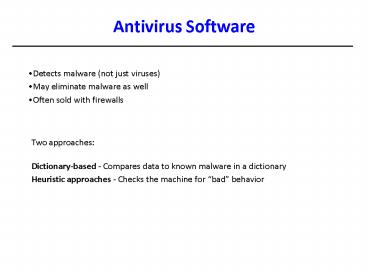Final Defense Talk - PowerPoint PPT Presentation
1 / 7
Title:
Final Defense Talk
Description:
Antivirus Software. Detects malware (not just viruses) May eliminate malware as well ... A malware dictionary is essentially a blacklist, describing 'bad' software ... – PowerPoint PPT presentation
Number of Views:43
Avg rating:3.0/5.0
Title: Final Defense Talk
1
Antivirus Software
- Detects malware (not just viruses)
- May eliminate malware as well
- Often sold with firewalls
Two approaches Dictionary-based - Compares data
to known malware in a dictionary Heuristic
approaches - Checks the machine for bad behavior
2
Dictionary-Based Approach
- Scan files on disk (and in memory) and compare
them to known malware - If a match is found then malware is detected
- Once malware is detected, one of the following
actions is performed - 1. Repair the file (if possible)
- 2. Quarantine the file (change access privileges)
- 3. Delete the file
3
Dictionary-Based Details
- Typically examines files when the OS performs
create, open, close or emails them - All files are scheduled to be scanned on a
regular basis - - Maybe a new file has mysteriously appeared
- Virus dictionary must be updated regularly
- - Need to catch 0day attacks
- - Updates must be secure
4
Blacklisting vs. Whitelisting
- A malware dictionary is essentially a blacklist,
describing bad software - - Any software in the blacklist is known bad
- There are so many different types of malware that
it is hard to make a complete dictionary - A whitelist is a list of known good software
- - Software not on the white list is assumed to
be bad - Similar to Deny-All for firewalls
5
Weaknesses of Dictionary-Based
- Cannot detect new malware
- - Virus must be in the dictionary to be detected
- - Time to include in a dictionary can vary
- - Different malware often shares code (i.e.
metasploit) - Small changes in malware can make it undetectable
- - There are many ways to write the same program
- - Polymorphic worms are encrypted to avoid
detection
6
Heuristic Antivirus Techniques
- Monitor the behavior of all programs
- If the behavior is suspicious then malware is
detected - Example Writing data to an executable program is
suspicious - - Viruses do this to spread
- Benefits
- - Can detect new malware
- Weaknesses
- - Hard to define suspicious behavior
- - Many false positives are possible
- - Malware writers can adjust to the heuristics
7
Issues with Antivirus
- Antivirus tools may not properly clean up after
eliminating malware - Antivirus tools may significantly slow down your
machine - Cannot use more than one antivirus tool at one
time - - Antivirus operations are suspicious
- May need to disable antivirus when making
low-level changes - - Installing a windows service pack or video
drivers - - Modifying OS and drivers is suspicious































